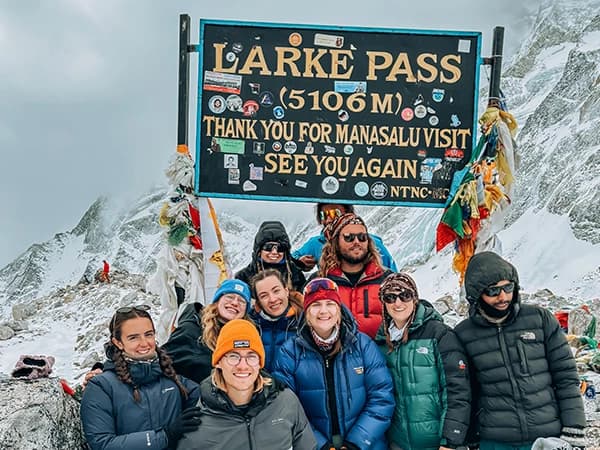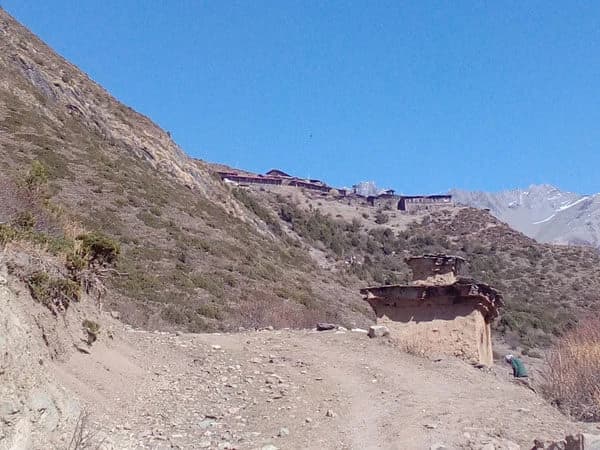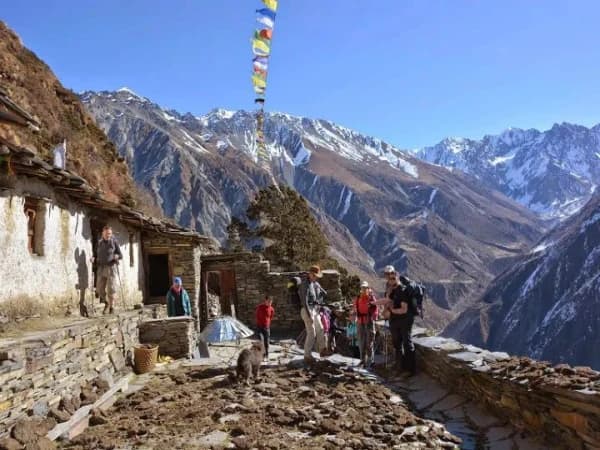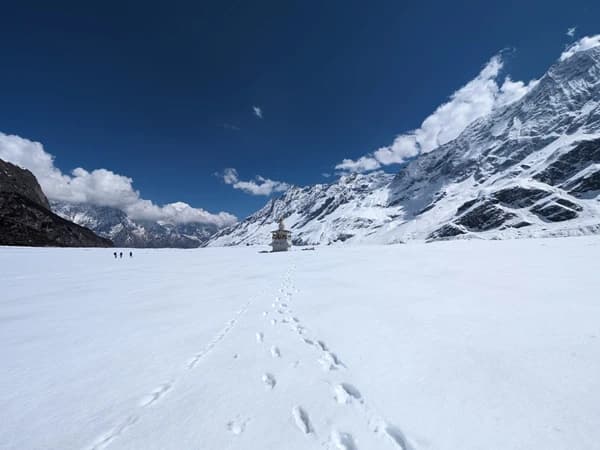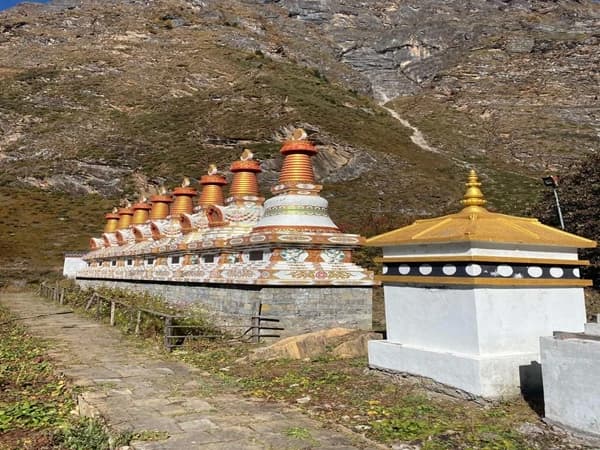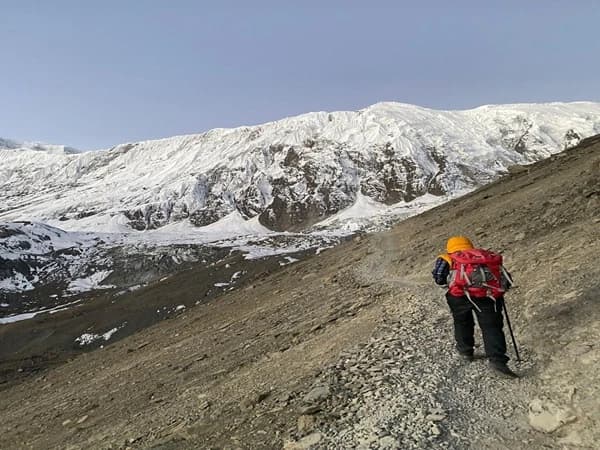Manaslu Region is named after the world’s eighth highest peak, Mt. Manaslu (8163m). The region offers a trekking experience that is much more raw and less commercialized in the heart of the Nepalese Himalayas.
The Manaslu Region lies in west-central Nepal, in the Gorkha District, and you will come across a richness in culture, the chance to visit remote villages, and a variation of altitude and scenery. Manaslu is named as per the Sanskrit word Manasa, which means 'soul' or 'spirit' and means mountain of the spirit.
This area houses Manaslu Circuit Trek, one of the most unique and beautiful trekking routes in all of Nepal, whereby trekkers will be treated to very scenic views of Mt. Manaslu, the other also notable peaks like Himalchuli and Ngadi Chuli, and be immersed in the rich culture embodied in Tibetan Buddhism expressed in the monasteries and Mani walls trekkers will encounter.
The magnificent and spectacular Manaslu Region is restricted and, therefore, has considerably less foot traffic than the other more popular trekking trails found in the Annapurna and Everest Region. Manaslu offers the ultra-rare and authentic, more pristine trekking experience for trekkers.
Facts to Know About the Manaslu Region
- Location: West-central Nepal, Gorkha District.
- Main Peak: Mt. Manaslu (8163m) – 8th highest in the world.
- Best Trek Name: Manaslu Circuit Trek.
- Trek Duration: 12 to 18 days.
- Culture: Tibetan-influenced Buddhism.
- Popular Pass: Larkya La Pass (5106m).
- Wildlife: Snow leopards, Himalayan Tahr.
- UNESCO Area: Part of Manaslu Conservation Area.
- Local Ethnic Groups: Gurung and Tibetan communities.
- Required Permits: RAP, MCAP, ACAP.
What Draws Trekkers to the Manaslu Region?
The Manaslu region is a trekking destination of pristine beauty where you can experience a unique culture and trek on trails that are far off the beaten path. Unlike most commercialized trekking routes, the Manaslu region allows trekkers to have a true sense of remote wilderness trekking through the traditional villages, ancient monasteries and a really splendid variety of landscapes featuring lush forests and looming Himalayan snow-peaks.
When talking about the Manaslu region, you cannot escape the obvious highlight of Mt. Manaslu (8163m), the eighth-highest mountain in the world. Trekkers will pass some important highlands and get incredible views of Manaslu and some other peaks in the region, such as Himalchuli and Ngadi Chuli. Another incredible highlight of the trek to Manaslu includes crossing the Larkya La Pass (5106m).
Cultural immersion is another major draw. The area is a bastion of Tibetan Buddhism, and along the way, you will see stone mani walls, prayer flags and old gompas. The trek goes through remote villages inhabited by Gurung and Tibetan origin communities and you will see a way of living that has changed very little in centuries.
The Manaslu trek is in a restricted area and requires special permits to enter its premises. This special area, with many amazing trekking opportunities, nature, and culture, is one of the preferred areas to go to for those wanting remote adventure and solitude in the Himalayas.
Top 5 Popular Manaslu Region Packages of all Time
Manaslu Circuit Trek – 12 Days
Kathmandu → Soti Khola → Machha Khola → Samagaon → Larkya La Pass → Dharapani → Kathmandu
The Manaslu Circuit Trek 12 days takes you to the high-altitude area encircling Mt. Manaslu (8163m), which is the eighth-highest peak in the world. The trek begins in Kathmandu, travelling by road to Soti Khola, with the trek starting as a pleasant walking route through a series of villages, forests, and river gorges. The trail is an uphill gradient into Samagaon, a beautiful village near Manaslu Base Camp. On arrival at Samagaon, the group can visit the ancient monasteries, as well as acclimatize to the higher altitude environment. The highlight of the trek is the steep ascent to Larkya La Pass (5106m), where the group is treated to an amazing view of the range of mountains and peaks around.
Short Tsum Valley Trekking – 10 Days
Kathmandu → Maccha Khola→ Lokpa → Chumling → Chhokang Paro → Rachen Gompa → Lokpa → Kathmandu
The short 10-day Tsum Valley Trek provides a cultural excursion into the sacred, isolated and spectacular Tsum Valley, known as the “Hidden Valley of Happiness.” From Kathmandu, we will drive to Arughat, then trek on peaceful trails until we arrive in Lokpa, the entry point to Tsum.
This shorter version of the classic Tsum trek is a great expedition for trekkers wishing to explore authentic Tibetan culture, isolated Himalayan villages, and tranquil mountain scenery without the hassle of crossing a high pass. It is a fabulous spiritual and picturesque trek for those who wish to experience nature and culture.
Tsum Valley Trekking - 17 Days
Kathmandu → Soti Khola → Maccha Khola→ Lokpa → Chumling → Chhokang Paro → Mu Gompa → Ganesh Himal Base Camp → Maccha Khola→ Kathmandu
If you want complete immersion in one of the most beautiful and isolated valleys in the Himalayas, you should consider taking this 17-day Tsum Valley Trek. This trek begins with a drive from Kathmandu to Arughat, and eventually, the trail gradually follows the Budhi Gandaki River. Although the trek is long and enjoys some healthy ups and downs, the reward is that, finally, trekkers have days to explore and enjoy Tsum Valley – a living, cultural Tibetan Buddhist heritage.
En route, trekkers visit various traditional villages such as Chumling, Chhokang Paro, and Nile, and finally, they get to Mu Gompa - the highest point of the trek. Here, you have the most amazing views of the Tsum Valley and enjoy a peaceful, spiritual atmosphere.
During the trek, trekkers will also visit a number of monasteries, including the very ancient Rachen Gompa, and connect with the hospitable people, mostly of Tibetan origins.
Manaslu Circuit Tsum Valley Trekking - 20 Days
Kathmandu → Maccha Khola→ Lokpa → Tsum Valley → Mu Gompa → Namrung→ Samagaon → Larkya La Pass → Dharapani → Kathmandu
The 20-day Manaslu Circuit Tsum Valley Trek incorporates both treks into a combined journey, which showcases some of the most culturally rich areas of Nepal with stunning scenery. The trek begins in Maccha Khola; from there, the route goes into the holy Tsum Valley, with a strong Tibetan Buddhist culture, incredible monasteries such as Mu Gompa, and a whole different cultural feel. Once in the Tsum Valley, the trail rejoins the Manaslu Circuit Trek, which this time makes its way through the alpine villages toward Samagaon. From Samagaon, the trek proceeds toward the stunning Larkya La Pass (5106m), which many say is the most difficult and rewarding part of the Manaslu Circuit.
Manaslu With Annapurna Circuit Trekking - 22 Days
Kathmandu → Soti Khola → Samagaon → Larkya La Pass → Dharapani → Manang → Thorong La Pass → Jomsom → Pokhara
The beautiful Manaslu with Annapurna Circuit Trek is a spectacular combination of two classic trekking routes in Nepal, all in one place over 22 days. Starting at Soti Khola, you will hike the Manaslu Circuit trekking route, visiting remote villages and some rugged mountain trails to discover the Larkya La Pass (5106m) while being amazed by the beauty of Mt. Manaslu and its surrounding peaks. You will cross the Larkya La Pass and enter into the Annapurna region by linking onto the very popular classic Annapurna Circuit trek to Manang and ending up crossing the Thorong La Pass (5416m), which is the highest point of this trek. The trek ends in Jomsom and you will have the option of a flight or driving to Pokhara. All in all, this trek has the best mix of high mountain passes, culture and wonderful trekking scenery.
How Much Does the Manaslu Region Treks Cost?
1. Trekking Package Price
A cost of trek in the Manaslu Region is on average $900 to $1,800 per person for a standard package. The variation in price is due to several things - the number of days trekking, trek selected (Manaslu Circuit vs. Manaslu + Tsum Valley), group size, services provided, and so on. Typically, the longer trek costs will typically be greater, such as the Manaslu with Annapurna Circuit trek (22 days).
2. Manalsu Permit Fees
- As Manaslu is a restricted area, special permits must be obtained.
- Restricted Area Permit (RAP): $100 for the first 7 days (September–November) and then $15.00/day
- Manaslu Conservation Area Permit (MCAP): $30
- Annapurna Conservation Area Permit (ACAP): $30
- Tsum Valley Permit: $40 to $70 depending on the season.
3. Guide and porter costs
A licensed guide will cost $25-35 per day, and a porter will cost $18-25 per day. Guides are required since this is a restricted zone.
4. Other expenses
Other expenses are meals, gear rental, travel insurance, etc., and transportation costs to/from the trailhead. Expect to budget at least $10-20 per day for food and drinks.
What are the Best Months and Season to Trek to Manalsu Region?
Best Time
The best months for trekking in the Manaslu Region are March to May and September to November. At that time of the year, clear skies, good weather, and beautiful mountains, such as Mt. Manaslu (8163m), the eighth-highest peak in the world, are the first things to notice.
- Spring (March to May): Spring brings the melting of snow, the blossoming of flowers, and the drying of paths. When nature is alive again, it is the best time to see it. In addition, with the stunning visibility, passes crossing like Larkya La Pass (5106m) are generally possible and safer.
- Autumn (September to November): This is the second-best period when most people trek. The air is fresher after the rains, the skies are clearer, the temperatures are generally milder, and the paths are dry. October is the perfect month in autumn suitable for Manaslu region treks.
Off Season Trekking
While not as common, off-season trekking may have beautiful trails (and you may see even fewer trekkers). Off-season trekking has its own set of challenges and should also be approached cautiously.
Winter (December to February): Although it will be very difficult, you can still go for a winter trek. High altitudes experience heavy snow and passes might be closed. However, if experienced trekkers have the right equipment they can still experience the tranquility of the region even if it is winter.
Monsoon/Summer (June to August): Monsoon and Summer season coincides in Nepal, and during the monsoon season, it rains heavily, creating muddy and slippery trails. Compared to the monsoon season, if you want to travel to Manalsu during off-season times, winter might be better than the summer times. In addition, there are risks of landslides and poor visibility. The monsoon season is not for you unless you are an experienced trekker and prepared to deal with wet and changeable conditions.
What kind of Flora and Fauna can you see on the Manaslu Region Trekking Routes?
The Manaslu Conservation Area has an enormous range of flora and fauna due in large part to the altitude presence, from low-altitude forests to alpine meadows. The variation of plant and animal life as you increase in altitude makes this trek both a visual delight and a wonder of nature to experience.
Flora in the Manaslu Region
The lower elevations are all subtropical forests of sal, alder and schima. As trekkers gain altitude above 3,000 meters, they would find temperate forests of oak, maple, fir and pine. Above 3,000 meters, the vegetation is alpine with varieties of juniper, the birch tree, rhododendrons, and wild medicinal plants like Yarshagumba.
|
Plant Type |
Examples |
|
Subtropical Trees |
Sal (Shorea robusta), Schima, Alder (Alnus), Chestnut |
|
Temperate Trees |
Oak (Quercus), Pine, Fir (Abies), Maple |
|
Alpine Trees/Shrubs |
Juniper, Birch (Betula utilis), Rhododendron (R. arboreum, campanulatum) |
|
Herbs & Flowers |
Yarshagumba, Primrose, Edelweiss, Blue Poppy, Gentian, Daphne, Lichens |
Fauna in the Manaslu Region
This area is home to 33 mammal species, more than 110 bird species, 11 butterfly species, and 3 species of reptiles. Wildlife characteristics can include common and endangered species. If the trekkers are lucky and patient enough, they might also find other classified animals located at higher altitudes, such as the snow leopard and red panda.
|
Animal Type |
Examples |
|
Mammals |
Snow Leopard, Red Panda, Musk Deer, Himalayan Tahr, Blue Sheep, Grey Wolf, Himalayan Marmot |
|
Birds |
Himalayan Monal, Snow Partridge, Lammergeier, Griffon Vulture, Golden Eagle, Kalij Pheasant |
|
Butterflies |
Common Yellow Swallowtail, Clouded Apollo, Painted Lady |
|
Reptiles |
Himalayan Agama, Common Skink, Himalayan Pit Viper |
Difficulty Level of Manalsu Region Treks
Manaslu Region trekking is moderately strenuous, so people with previous trekking experience are well-suited for these treks. Beginner trekkers can also complete the treks comfortably with good preparation. These treks are, at times, steep and remote and include high-altitude passes crossing such as the Larkya La (5,106m). The treks are not particularly technical but will require good all-around fitness. While the treks can be modified to fit your pace and comfort, you can be assured of a trekking experience that is rewarding, safe, and somewhat off-the-beaten-track trekking opportunities in Nepal and the Himalayan region. itineraries can be customized based on your level of difficulty.
How to Be Prepared for Trekking to the Manaslu Region?
Develop stamina: Start your cardiovascular conditioning (hiking, running, cycling), plan to do so 2 to 3 months out from your trek.
Mentally prepare: Understand the logistics around your trek and think about staying in the present through mindfulness/meditation.
Be smart about acclimatization: When looking at itineraries, find one with several rest and acclimatization days so that you can decrease your risk of altitude-related symptoms.
Be realistic in expectation: Have a realistic idea of how many hours of hiking (10 - 14), a lot of elevation gain (4000-5500m), and significant altitude passes (e.g. Larkya La, 5,106m).
Backpack customization: Start to train and hike with a weighted pack so you can get used to how your gear will feel and how it will feel to hike with a weighted pack.
Use the Right Gear: You want to make sure to have everything needed for your trek. Make sure you wear your trekking boots, pole, wear a headlamp, take gloves, sunglasses and have a good sleeping bag.
Hire a Guide and Porter: You should consider trekking with licensed guides and porters if they are available for your safety & navigation.
Accommodation and Facilities in manaslu Region
Trekkers and trekkers in the Manaslu region can find a variety of teahouses and lodges along and around the Manaslu Circuit. Most of the teahouses in the region will provide twin-sharing rooms with clean sheets and pillows with shared bathrooms. Most teahouses and lodges will also provide hot showers, wi-fi, and charging stations for an extra fee.
As trekkers gain elevation, the offerings will decrease, but no matter what, they will always be welcomed with a smile and warm hospitality. In addition, on the other hand, if the trekkers are in a very remote region or on a restricted trail, they can still do some camping.
If the trekkers pre-booked the trek in the region with a local trekking company, they usually guarantee better lodging and amenities at every stop on the trek.
Food and Beverages:
In the Manaslu region, meals are largely dictated by the traditional hearty tastes of Nepal: dal bhat ( rice, lentils and vegetables), noodles, soup, fried rice, and momos. Tea houses in the Manaslu trek offer menus with all of those things in a variety of options, and usually have a few basic western foods (pancakes, pasta, and eggs).
There are vegetarian meals available everywhere, while meat meals are typically not recommended at high altitudes because freshness is a concern. Drinks include tea, coffee, hot lemon and bottled or boiled water. Alcohol is available mainly in some of the lower villages, but avoid to get better acclimatize. You can also bring energy bars and snacks with you from Kathmandu.
How to reach the Starting Point for Nepal Manaslu Region Trekking?
If you want short and long manalsu holiday plans, we also operate short treks in the Manaslu region of 10, 12, 17, 20, 14 and 22 days, depending on your needs. Usually, the treks start with a drive from Kathmandu to Machha Khola or a little bit further along that route, depending on road conditions.
Drive from Kathmandu to Soti Khola
Most commonly, you will start the Manaslu trek by taking a bus or van from the capital of Nepal, Kathmandu, to Soti Khola, in the Gorkha District. The distance is roughly 140+ km to Soti Khola, and the total time will be from 8-10 hours, depending on traffic and the state of the road. You will travel first from Kathmandu to Dhading, then on to Arogat, and ultimately to Soti Khola. The scenery is beautiful.
- Private Jeep: More luxurious, fast travel, and ideal for families or small parties, perfect for those that like flexibility in their trip. Costs USD 200-250 a jeep.
- Shared Jeep: This can be arranged through a local agency. Average cost is approx. USD 25-35 per person.
- Public Bus: The buses leave from Gongabu bus park in the early morning hours (7 am) in Kathmandu to Arughat or Labubesi. From here you would take a local jeep to continue your way. The average cost is USD 8-10 per person. Expect travel conditions to be more basic than a scheduled limited daily bus and longer travel time.
Drive to Machha Khola – Starting a Bit Farther Ahead
Some trekkers also start the trek from Machha Khola and skip the first day of trekking from Soti Khola. This would allow one less day of trekking overall.
Private Jeep - Approximately 10-12 hours. USD 250-300 per jeep.
Shared Jeep - Not as common, but possible with some coordination with trekking agencies.
Public Transport - No bus directly from Pokhara to Machha Khola, it is possible but with a lot of transfers and a much longer time. This is not a recommended option for someone unfamiliar with this area.
Option via Arughat Bazar – For Tsum Valley and Side Routes
Arughat Bazaar is an important transit point and also a possible starting point for the treks to Manaslu and Tsum Valley.
- Private jeep: 6-7 hours. Cost: USD 180-220
- Public bus: Regularly services Kathmandu. Cost: 7-10. You will usually need to connect to the local jeep to Soti Khola or point further upstream.
Helicopter Charter
There are not a lot of flights by Helicopter. But helicopter charters are possible for drop-off in Gorkha, Arughat, and Jagat. Availability of helicopter charters and drop-off schedules for sightseeing clients is dependent on weather and pilots.
Flight time is approximately 1 hour from Kathmandu
- Cost: The cost of a charter helicopter will be dependent on the destination and the number of people. Starting price: USD 2000-3000 per flight.
- Depending on trekking style, hikers may consider a helicopter charter for luxury treks or limited-time, or photography/filming purposes.

